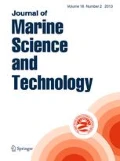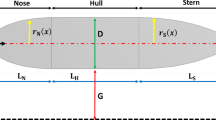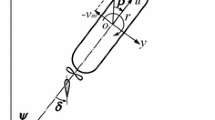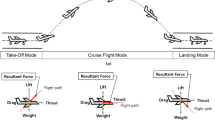Abstract
Unsteady Reynolds averaged Navier–Stokes (URANS) computations of standard maneuvers are performed for a surface combatant at model and full scale. The computations are performed using CFDShip-Iowa v4, a free surface solver designed for 6DOF motions in free and semi-captive problems. Overset grids and a hierarchy of bodies allow the deflection of the rudders while the ship undergoes 6DOF motions. Two types of maneuvers are simulated: steady turn and zigzag. Simulations of steady turn at 35° rudder deflection and zigzag 20/20 maneuvers for Fr = 0.25 and 0.41 using constant RPM propulsion are benchmarked against experimental time histories of yaw, yaw rate and roll, and trajectories, and also compared against available integral variables. Differences between CFD and experiments are mostly within 10 % for both maneuvers, highly satisfactory given the degree of complexity of these computations. Simulations are performed also with waves, and with propulsion at either constant RPM or torque. 20/20 zigzag maneuvers are simulated at model and full scale for Fr = 0.41. The full scale case produces a thinner boundary layer profile compared to the model scale with different reaction times and handling needed for maneuvering. Results indicate that URANS computations of maneuvers are feasible, though issues regarding adequate modeling of propellers remain to be solved.

















Similar content being viewed by others
Abbreviations
- a ij :
-
Wave amplitude
- a e :
-
Surface area of solid surface
- A :
-
Bretschneider coefficient which depends on wave period and wave height
- A θ :
-
Coefficient for axial body force
- A x :
-
Coefficient for azimuthal body force
- B :
-
Bretschneider coefficient which depends on wave period
- C 1, C 2, C 3 :
-
Constants defining order of accuracy of 6DoF solver
- D p :
-
Propeller diameter
- f bx :
-
Axisymmetric body force in axial direction
- f bθ :
-
Axisymmetric body force in azimuthal direction
- F e :
-
Fluid forces in the earth reference system
- F prop :
-
Propeller forces in the ship reference system
- F ship :
-
Fluid forces in the ship reference system
- H 1/3 :
-
Significant wave height
- I x :
-
Moment of inertia about x-axis
- I y :
-
Moment of inertia about y-axis
- I z :
-
Moment of inertia about z-axis
- J :
-
Advance coefficient
- J :
-
Transformation matrix from \(\dot{{\varvec {\eta }}}\) to \( {\mathbf{v}} \)
- K i :
-
Wave number
- K Q :
-
Torque coefficient
- K T :
-
Thrust coefficient
- (K, M, N):
-
Moments in x, y, z direction
- L e :
-
Fluid moments in the earth reference system
- L ship :
-
Fluid moments in the ship reference system
- M :
-
Mass
- M(α i ):
-
Directional spectrum
- N :
-
Angular velocity of propeller
- p:
-
Pressure
- p :
-
Roll velocity
- \( \dot{p} \) :
-
Roll acceleration
- p 1 :
-
Upstream point of propeller volume
- p 2 :
-
Downstream point of propeller volume
- q :
-
Pitch velocity
- \( \dot{q} \) :
-
Pitch acceleration
- r :
-
Yaw velocity
- \( \dot{r} \) :
-
Yaw acceleration
- r :
-
Distance vector
- r h :
-
Propeller hub radius
- r p :
-
Propeller radius
- S(ω i ):
-
Frequency spectrum
- T m :
-
Modal wave period
- u :
-
Surge velocity
- \( \dot{u} \) :
-
Surge acceleration
- U :
-
Wave velocity in x-direction
- U ship :
-
Ship forward velocity
- v :
-
Sway velocity
- \( \dot{v} \) :
-
Sway acceleration
- V :
-
Wave velocity in y-direction
- w :
-
Heave velocity
- \( \dot{w} \) :
-
Heave acceleration
- W :
-
Wave velocity in z-direction
- x G, y G, z G :
-
Distance from the center of rotation to the center of gravity of the ship
- x CG, y CG, z CG :
-
Center of gravity
- x rot, y rot, z rot :
-
Center of rotation of ship
- (X, Y, Z):
-
Forces in x, y, z direction
- α:
-
Angle of incidence
- α 0 :
-
Heading angle
- α j :
-
Dispersion angle
- η(x 1, x 2, x 3, ϕ, θ, ψ):
-
Position and Euler angles
- \( \dot{\varvec{{\eta }}} \) :
-
Rate of change of position and Euler angles
- v :
-
Linear and angular velocity vector
- ξ:
-
Wave elevation
- µ j :
-
Angle of incidence
- ϕ ij :
-
Random phase
- φ :
-
Generic degree of freedom on 6DoF solver
- ω i :
-
Wave frequency
- Δt :
-
Time step
- ∇u :
-
Velocity gradient
- Δx :
-
Thickness of propeller disk
References
Larsson L, Stern F, Bertram V (2003) Benchmarking of computational fluid dynamics for ship flows: the Gothenburg 2000 workshop. J Ship Res 47:63–81
Hino T (ed) (2005) CFD workshop Tokyo 2005. National Maritime Research Institute, Japan
Carrica PM, Wilson RV, Noack R, Xing T, Kandasamy M, Stern F (2006) A dynamic overset, single-phase level set approach for viscous ship flows and large amplitude motions and maneuvering. In: 26th ONR symposium on naval hydrodynamics, Rome
Hochbaum AC, Vogt M (2002) Towards the simulation of seakeeping and maneuvering based on the computation of free surface viscous flows. In: 24th ONR symposium on naval hydrodynamics, Fukuoka
Carrica PM, Wilson RV, Noack R, Stern F (2007) Ship motions using single-phase level set with dynamic overset grids. Comput Fluids 36:1415–1433
Jensen G, Klemt M, Xing Y (2004) On the way to the numerical basing for seakeeping and maneuvering. In: 9th symposium on practical design of ships, Luebeck
Pankajakshan R, Remotigue S, Taylor L, Jiang M, Briley W, Whitfield D (2002) Validation of control-surface induced submarine maneuvering simulations using UNCLE. In: 24th ONR symposium on naval hydrodynamics, Fukuoka
Venkatesan G, Clark W (2007) Submarine maneuvering simulations of ONR body 1. In: Proceedings of OMAE2007, San Diego
Muscari R, Broglia R, Di Mascio A (2008) Trajectory prediction of a self-propelled hull by unsteady RANS computations. In: 27st ONR symposium on naval hydrodynamics, Seoul
Carrica PM, Stern F (2008) DES simulations of the KVLCC1 in turn and zigzag maneuvers with moving propeller and rudder. In: Proceedings of SIMMAN 2008, Copenhagen
Stern F, Toxopeus SL, Visonneau M, Guilmineau E, Lin WM, Grigoropoulos G (2011) CFD, potential flow, and system-based simulations of course keeping in calm water and seakeeping in regular waves for 5415M. NATO AVT-189 meeting, Portsdown
Crane CL (1979) Maneuvering trials of 278000-DWT tanker in shallow and deep waters. Trans SNAME 87:251–283
Stern F, Agdrup K (eds) (2008) SIMMAN 2008 workshop on verification and validation of ship maneuvering simulation methods, Copenhagen
Simman 2008. http://www.simman2008.dk/
Stern F, Agdrup K, Kim SY, Hochbaum AC, Rhee KP, Quadvlieg F, Perdon P, Hino T, Broglia R, Gorski J (2011) Experience from SIMMAN 2008—the first workshop on verification and validation of ship maneuvering simulation methods. J Ship Res 55:135–147
Carrica PM, Wilson RV, Stern F (2006) Unsteady RANS simulation of the ship forward speed diffraction problem. Comput Fluids 35:545–570
Sakamoto N, Carrica PM, Stern F (2008) URANS simulations for static and dynamic maneuvering for a surface combatant. In: Proceedings of SIMMAN 2008, Copenhagen
Mousaviraad M, Carrica PM, Stern F (2010) Development and validation of harmonic wave group single-run procedure for RAO with comparison to regular wave and transient wave group procedures using URANS. Ocean Eng 37:653–666
Carrica PM, Wilson RV, Stern F (2007) An unsteady single-phase level set method for viscous free surface flows. Int J Numer Meth Fluids 53:229–256
Bhushan S, Xing T, Carrica PM, Stern F (2009) Model- and full-scale URANS Simulations of Athena resistance, powering and seakeeping, and 5415 maneuvering. J Ship Res 53:179–198
Sethian JA, Smereka P (2003) Level set methods for fluid interfaces. Ann Rev Fluid Mech 35:341–372
Noack R (2005) SUGGAR: a general capability for moving body overset grid assembly. In: 17th AIAA CFD conference, 2005–5117, Toronto
Boger DA, Dreyer JJ (2006) Prediction of hydrodynamic forces and moments for underwater vehicles using overset grids. In: 44th AIAA aerospace science meeting and exhibit. AIAA-2006-1138, Reno
Ismail F, Carrica PM, Xing T, Stern F (2010) Evaluation of linear and non-linear convection schemes on multidimensional non-orthogonal grids with applications to KVLCC2 tanker. Int J Numer Meth Fluids 64:850–886
Menter FR (1994) Two-equation eddy viscosity turbulence models for engineering applications. AIAA J32:1598–1605
Wallin S, Johansson A (2000) An explicit algebraic Reynolds stress model for incompressible and compressible turbulent flows. J Fluid Mech 403:89–132
Travin A, Shur M, Strelets M, Spalart PR (2002) Physical and numerical upgrades in the detached-eddy simulation of complex turbulent flows. In: Friederich R, Rodi W (eds) Fluid mechanics and its applications. Advances in LES of complex flows, Proceedings of EUROMECH colloquium 412, vol 65. Kluwer Academic Publishers, Dordrecht, pp 239–254
Issa RI (1985) Solution of the implicitly discretized fluid flow equations by operator splitting. J Comp Phys 62:40–65
Bell JB, Collela P, Howie LH (1991) An efficient second order projection methods for incompressible viscous flows. In: 10th AIAA CFD conference, Honolulu
Beck R, Cummins W, Dalzell J, Mander P, Webster W (1989) Motions in waves. In: Lewis E (ed) Principles of naval architecture, Chap. VIII
Mousaviraad SM, Carrica PM, Huang J, Stern F (2008) CFD prediction of ship response to severe ocean waves and wind. In: 27st ONR symposium on naval hydrodynamics, Seoul
Stern F, Kim HT, Patel VC, Chen HC (1988) A viscous-flow approach to the computation of propeller-hull interaction. J Ship Res 32:263–284
Carrica PM, Paik K, Hosseini H, Stern F (2008) URANS analysis of a broaching event in irregular quartering seas. J Mar Sci Technol 13:395–407
Fossen TI (1994) Guidance and control of ocean vehicles. Wiley, New York
Carrica PM, Stern F (2010) Self-propulsion computations using speed controller and discretized propeller with dynamic overset grids. J Mar Sci Technol 15:316–330
Acknowledgments
This research was sponsored by Office of Naval Research grant N00014-01-1-0073 under the administration of Dr. Patrick Purtell. Computations were performed on the IBM Power 5 at the Department of Defense NAVO Major Shared Resource Center and on the SGI Altix 4700 at the NASA Advanced Supercomputing Division.
Author information
Authors and Affiliations
Corresponding author
Electronic supplementary material
Below is the link to the electronic supplementary material.
Supplementary material 1 (MPG 6084 kb)
Supplementary material 2 (MPG 7954 kb)
Supplementary material 3 (MPG 4372 kb)
Supplementary material 4 (MPG 8062 kb)
About this article
Cite this article
Carrica, P.M., Ismail, F., Hyman, M. et al. Turn and zigzag maneuvers of a surface combatant using a URANS approach with dynamic overset grids. J Mar Sci Technol 18, 166–181 (2013). https://doi.org/10.1007/s00773-012-0196-8
Received:
Accepted:
Published:
Issue Date:
DOI: https://doi.org/10.1007/s00773-012-0196-8




